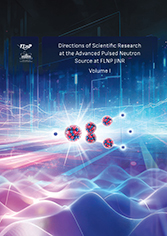FLNP JINR published book on directions of research at prospective neutron source
News, 03 July 2025
The Frank Laboratory of Neutron Physics at JINR is actively developing a project for a promising pulsed neutron source that will replace the IBR-2 Reactor in the 2040s. Together with scientists from the Institute’s Member States and laboratories interested in the creation of the facility, the first volume of a book series dedicated to the new neutron source was issued. “Directions of research at the advanced FLNP JINR pulsed neutron source” presents an analysis of research that should remain significant for more than 20 years and can be carried out at the advanced pulsed research neutron source. Materials about the neutron source itself and the instruments under development that will allow conducting these studies will be published later.
 “We plan to publish three volumes that will help us back the creation of a new high-flux source that we hope will replace the IBR-2. The first book will focus on research directions, the second one will detail instruments that the source should have, and the third one will describe the source itself. Since it will take quite a long time to create the future reactor, the first volume may undergo changes, but the main directions from the proposed list should stay the same”, – FLNP Director Egor Lychagin commented.
“We plan to publish three volumes that will help us back the creation of a new high-flux source that we hope will replace the IBR-2. The first book will focus on research directions, the second one will detail instruments that the source should have, and the third one will describe the source itself. Since it will take quite a long time to create the future reactor, the first volume may undergo changes, but the main directions from the proposed list should stay the same”, – FLNP Director Egor Lychagin commented.
The main challenges of the modern civilisation that humanity faces are related to population growth, health and environment concerns, availability of clean water, food and energy, means of communication, storage and processing of large amounts of data, solving transport issues, ensuring comfort and safety, and much more. As the scale and importance of these and other problems of society become more and more clear, researchers from the JINR Member States face new challenges in condensed matter and soft matter physics, arising in industry, economics, society, and scientific community.
The Joint Institute for Nuclear Research needs the most cutting-edge experimental facilities to be able to respond to these challenges. Expanding the opportunities for collective access to instruments at the advanced pulsed neutron source in the Frank Laboratory of Neutron Physics, the only pulsed high-flux neutron source in the JINR Member States, will undoubtedly contribute to this. The book analyses the significance of proposed scientific directions over the next 20 years in relation to the project of the new advanced pulsed research neutron source at FLNP at JINR. In addition, the authors detail the methods, components of facilities, and their optimisation in combination with the parameters of the source, along with the development of auxiliary laboratory and computing facilities.
